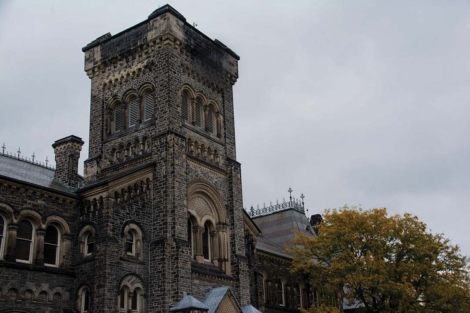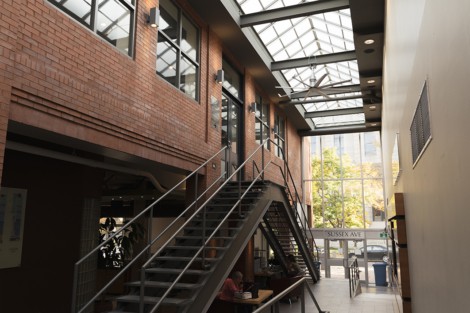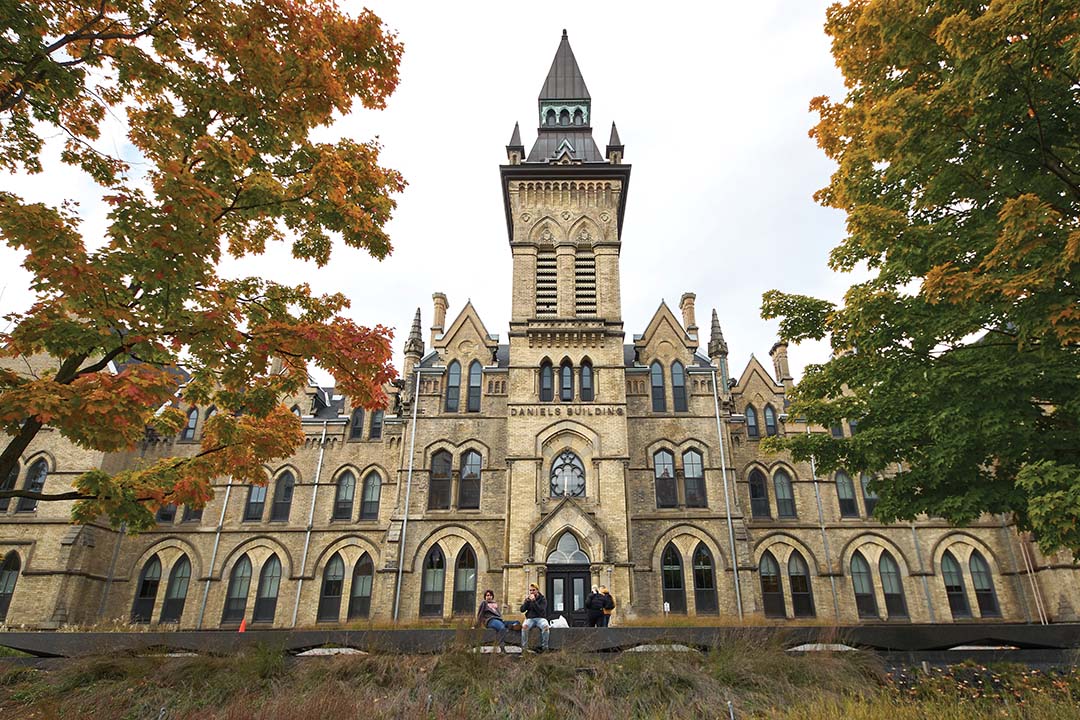U of T’s rich and expanding architectural landscape started back in 1859 with the completion of its first permanent building: University College (UC), designed by Cumberland & Storm, an architectural firm established in 1852. Since then, a wide variety of buildings encompassing styles across many different architectural movements have found their home on campus. Modern structures complement and play off of older buildings in this ever-growing architectural zoo.
A mixed bag of styles
Although U of T was established as the successor to King’s College — an Anglican university that was established through the same grant as U of T and closed in 1848 — in 1850, the UC building was completed in 1859. For nine years, the school existed in temporary spaces. When UC was completed, it marked the beginning of U of T’s architectural contribution to Canada. The collection of U of T’s colleges soon joined the ranks one by one, with each college’s architect given stylistic freedom when designing their buildings.

ZEYNEP POYANLI/ THE VARSITY
U of T’s eclectic approach has resulted in a motley collection of styles that define the old buildings on campus. UC is a unique medieval Romanesque Revival-style building; St. Michael’s College consists of the Gothic Revival St. Basil Church, built in 1856, alongside various historic houses of the 1890s era of different transitional styles; Victoria College, built in 1892, embodies a Richardsonian Romanesque style; and Trinity College, built in 1925, is built in a Collegiate Gothic style.
Moving further into the twentieth century, we got New College in 1962, Innis in 1964, and Woodsworth in 1974, all built in a modern style with brick, a rather traditional material. This type of homage to the past is characteristic of U of T’s campus and is readily apparent in Innis College’s incorporation of a renovated nineteenth-century Victorian townhouse’s facade, situated alongside a modern addition built in matching orange brick, steel, and glass.

NICHOLAS TAM/ THE VARSITY
Next to Innis, the Max Gluskin House, renovated in 2008, also artfully integrates historic houses by linking them with glass and steel additions along with an intentionally rusted bright orange steel facade in the courtyard that color-matches the older orange brick buildings around it. This meeting of old and new is also present in the iconic Daniels building, which is home to U of T’s architecture faculty. Daniels is composed of the old One Spadina crescent building, built in 1875, which remains intact and is facing the south along with a grand and new modern added segment from 2017 facing the opposite direction to the north.
Meanwhile, Massey College offers a different take on incorporating the past into modern structures. Designed by Ron Thom and built in 1963, this project was a nonstandard blend of traditional and modern styles resulting in a truly unique building defying the architectural laws of its time. The modern school of architecture at the time rejected ornamentation and instead put significant emphasis on exploring new forms and materials, while traditionalists differed by following a strict set of forms with no interest in abstraction. In the 1960s, a modernist building with ornamentation was just as unheard of as a traditional building with abstract design — yet Massey College gracefully brings abstract forms and ornamentation together in a traditional courtyard layout, making it a unique example of what could be considered early postmodernism.
The Medical Science building, built in 1969, is one example of U of T Brutalism built with heavy consideration for architecture’s relationship to public art. The sculpted concrete exterior facade was painstakingly crafted by artists Ted Bieler and Robert Downing and covers a majority of the building, blurring the line between art and architecture.
Another piece of pure modern architecture on campus is Robarts Library, built in 1973. Although popularly considered a horrendous sight by much of the student body, others believe the building is a powerful and intricate example of monumental Brutalism.
In an interview with The Varsity, Professor Emeritus and former Dean of the Daniels Faculty of Architecture Larry Richards pointed out that the library’s composition around the triangle and geometry is well planned out, and the rough type of concrete used commands respect. Richards also noted that Robarts does admittedly lack in design with regard to its relationship with the ground.
“I like Robarts a lot, [but] what was never very good about [it] is the way it meets the ground,” Richards explained. “You have these kind of monumental steps going up here, to the main level, but the real entries where everybody went in were sort of what looked like back doors or fire escapes.”
Regardless, Robarts is certainly an architecturally impressive and ambitious structure that brings character to the UTSG.
Reworking the old
Making sure older buildings are up to date is another important part of honouring the traditional architecture on campus. UC has gone through many repair renovations throughout its tumultuous past, including, recently, the 2018 accessibility and library renovation being led by Kohn Schnier architectural firm.
The ever-growing list of building standards means UC was due for an accessibility make-over. Although this would normally consist of a standard technical update to the building, Kohn Schnier takes a few clever design approaches to make this mundane task interesting.
A huge part of this is the elevator addition. The challenge of integrating an elevator into a stylistically medieval building was playfully met by the addition of the dark elevator shaft on the outside, decorated with large scales resembling the skin of a dragon. Although visibly modern, the zoomorphic addition works seamlessly with the building’s medieval style.
While some buildings get to be renovated, not all of them get to be saved. Sid Smith, built in 1960, is one such example. Although at first glance, the building doesn’t look like anything special, this concrete structure holds a well endeared position in the history of Toronto architecture as one of the first examples of the modern concrete slab and podium form and radical structure.
Its planned redevelopment, however, brings up the very complicated topic of heritage. Right across the street is the Sir Wilson Residence of UC, built in 1954, which is also another important building from the modern era designed by Mathers & Haldenby — the architectural firm that worked on Robarts. This building has designated protection status under Part IV of the Ontario Heritage act for being architecturally significant as an example of the twentieth century Georgian Revival style.
Sid Smith, on the other hand, does not have any level of heritage recognition, despite its history. Part IV of the Ontario Heritage allows for the designation of culturally or architecturally valuable buildings after a registration process to receive legal protection from demolition.
Richards spoke of the complicated value judgments that come with heritage. While old buildings such as Sid Smith or UC can certainly be preserved in their original form throughout renovations, preservation is a very costly process, and unless the building is of outstanding value, sometimes a smarter choice would be to redevelop the building completely. Despite the architectural significance of Sid Smith as an iconic modern trailblazer, parts of the building require demolition in order for the site to meet environmental and accessibility standards.
Ultimately, renovation complications are a money problem. There is no right or wrong answer, but at this early stage of planning, we don’t even know the architect and design associated with the redevelopment of Sid Smith yet. For now, there is little we can do but watch and wait.
A brighter future
The university provides a comprehensive list of its upcoming architectural projects to the public. The ambitious Landmark Project is one of the more obvious ones at UTSG. It aims to reconstruct King’s College Circle to include Canada’s largest urban geothermal field and an underground parking lot while making the surface level more walkable. This geothermal field aims to save an estimated 15,000 metric tons of greenhouse gas emissions per year, which will dramatically contribute to sustainability on campus.
Another project that Richards is particularly excited for is the Schwartz Reisman Innovation Centre being constructed at University Avenue and College Street, which will add a new pyramidal building to the character of U of T.
Richards brought up an important consideration for U of T’s future built environment: the advancement of technology and a future in virtual reality spaces. We’re already seeing the emergence of a virtual learning space, especially through the COVID-19 pandemic, and they will continue to grow. As virtual spaces develop, implications of the coexistence between physical and virtual worlds suggest new challenges and possibilities.
However, it is important not to forget the purpose served by history and physical structures. Although classes can be taken from home, that doesn’t mean they should be. Physical architecture has an important role as a sort of historical museum of the university, and the spaces provided for both in-person or virtual learning should be designed to spark educational inspiration.


